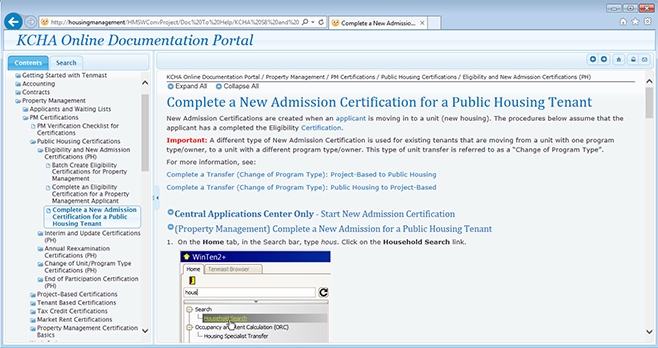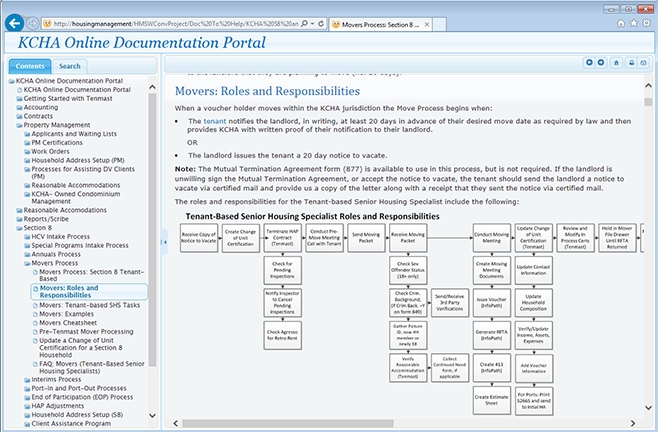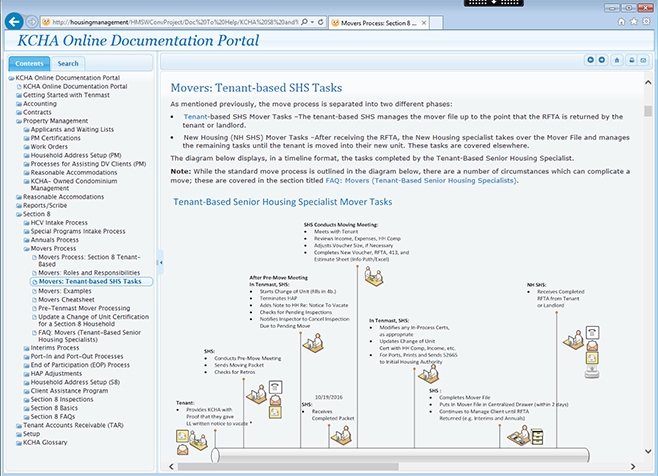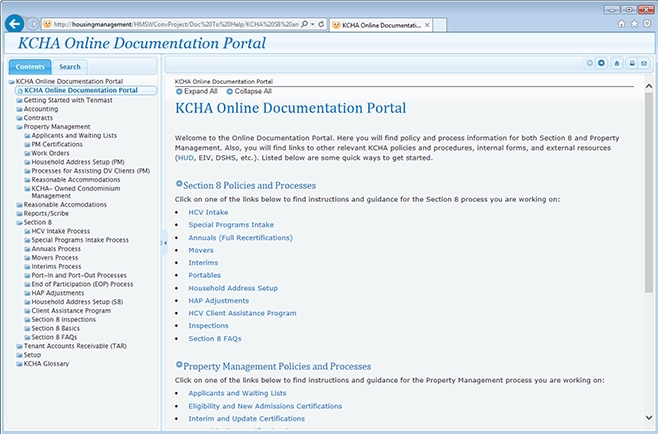Case Study | King County Housing Authority

King County Housing Authority Delivers Multimedia Online Help with MadCap Doc-To-Help
Goals:
- Streamline the process of developing and publishing online Help through content reuse.
- Enhance users’ experience by delivering online Help that makes it easier to navigate and find the information they need.
- Facilitate team collaboration and content management using Microsoft® Word.
Solutions:
- MadCap Doc-To-Help Microsoft® Word-based multi-channel authoring tool
Benefits:
- Efficiency – KCHA uses topics and tables of contents to facilitate content reuse and simplify the creation and delivery of a comprehensive online Help system featuring a single portal that services multiple departments in the agency.
- Enhanced User Experience – KCHA relies on screen shots and embedded diagram and timeline graphics to provide a modern, visually engaging web experience.
- Collaboration – Doc-To-Help’s support for Microsoft® Word and Microsoft® SharePoint® fosters collaboration between the KCHA writers and the other agency Subject Matter Experts, making it easier to create content and manage it long term.
- Easy Navigation – Expand/Collapse sections, search functionality, and embedded links to other sites make it easier for users to find and access information and only view what they want to see.
Website Portal Built Using Familiar Microsoft® Environment with MadCap Doc-To-Help Empower Employees with Information for Effectively Navigating Property Management and Section 8 Voucher Processes
King County Housing Authority (KCHA), a nationally recognized leader in quality affordable housing, provides rental housing and rental assistance to more than 18,000 households in King County, Washington. The organization owns and manages almost 3,500 units of subsidized housing for families, the elderly, and disabled people. An additional 5,680 units of other rental housing are financed through tax credits or tax-exempt bonds. KCHA’s Section 8 voucher program also helps more than 11,000 households rent affordable private-market housing.
Helping residents to find housing requires KCHA employees to navigate a broad set of agency and government guidelines to accurately complete their work. KCHA provides staff with a robust set of documentation that simplifies the learning process for both the Property Management and Section 8 voucher departments. Today, this documentation is delivered as modern online Help using the authoring and publishing capabilities of MadCap Doc-To-Help.

View of Collapsed Sections in Online Documentation Portal
MadCap Doc-To-Help serves as a content management system (CMS) that enables the KCHA writing team to create, manage, and repurpose content in a familiar Microsoft® Word environment. As a result, the organization now has a more efficient, agile approach to developing and delivering this content as a user-friendly online Help system that can be accessed from the software driving its processes.
Rethinking Documentation Delivery
For years, the Housing Authority employees completed their daily work on a mainframe-based property management software system. At the same time, their content strategy was a standard use of PDF documents covering policy, process, and procedural information for each department in the agency. As the organization looked to modernize, they decided to make a move to a more advanced, Windows-based property management software system and to modernize their approach to delivering documentation to the agency. To successfully launch the new system, the agency needed to create easily accessible, customizable, up-to-date documentation that would enable employees to use the new software system and that the writing team could easily update in real time.
KCHA also needed to share and maintain content between the different departments at the Housing Authority. The old strategy of creating separate documents for each department became increasingly difficult as the number and size of the paper documents grew. Instead, the KCHA writing team wanted the ability to reuse content that was applicable to both the Property Management and Section 8 departments, but still maintain some department-specific content.
“As a complex agency, taking on the challenge of an equally complex software system, we wanted a documentation and training platform that would support our staff in making the transition. We were looking for ways to make our operation more efficient and easily communicate to staff changes in policy guidelines, agency processes, and each individual’s roles and responsibilities in this new world.” explained Julie Badger, administrative program manager at KCHA. “Doc-to-Help gave us the opportunity to ensure that we have the highest level of clarity and efficiency in our operations.”
The need for a more efficient way to deliver content and ensure its consistency across departments led to an evaluation of CMS solutions. The search quickly led KCHA to MadCap Doc-To-Help, which checked off all of the organization’s requirements for reusing content, linking documents, managing workflows, and being able to quickly update and publish changes.
“MadCap Doc-To-Help was the perfect solution that had some technology around it but was still simple enough that our end users could give feedback, meet in teams, and edit content collectively,” Badger noted.

Example of Basic Graphics Integrated with Online Documentation Portal
Smooth Migration to MadCap Doc-To-Help
The migration to Doc-To-Help began in June 2015. Within five months, the KCHA Help website went live, with content written and published for both the Property Management and Section 8 teams, and in time for the software go live.
Today, KCHA’s writing team uses MadCap Doc-To-Help to deliver the online Help website, which is a single portal that is split into two sections: one for the Property Management department and the other for the Section 8 voucher department. This Help website enables staff from both sides of the agency to quickly complete their day-to-day work.
“Doc-To-Help helped us to create a modern, easily accessible online Help system that’s made it so much easier for workers to find the information they need and to better understand how to do their job following the correct policies and procedures,” explained Badger. “This is crucial because there are so many complex steps for each and every job function. And it’s really critical for people in the main office and people out in the field to be able to do their job following standard processes and procedures, so that they can better assist the participants in both the Property Management and Section 8 programs.”
“I was blown away by how we were able to reinvent KCHA’s documentation using Doc-To-Help. The documentation we created is more lean, organized, and robust than what I’ve seen in corporate America.”

Julie Badger
Administrative Program Manager | King County Housing Authority
At the same time, the move to MadCap Doc-To-Help has enabled to KCHA’s writers to provide timely updates online as changes to the software or housing policies occur. This ensures that employees have accurate information available through the intuitive, easy-to-use portal.
“Doc-To-Help fits perfectly with the lean engineering principles we adopted, allowing us to easily manage content and make it look really amazing,” Badger noted. “Having come from Microsoft® and worked on a Lean engineering team, I was blown away by how we were able to reinvent KCHA’s documentation using Doc-To-Help. The documentation we created is more lean, organized, and robust than what I’ve seen in corporate America.”
Maximizing Content Reuse
To support an agile approach, the KCHA team of writers makes extensive use of topics and table of contents (TOC) functionality in MadCap Doc-To-Help. This simplifies the process of creating content while streamlining authoring efforts.
“Since both Property Management and Section 8 share some of the same content on the website, being able to create and share topics in Doc-To-Help really enables us to maximize content reuse and consistency,” Badger noted. “It has drastically reduced the time it takes for us to develop and deliver content, and we no longer have the burden of maintaining duplicate manuals.”
Additionally, KCHA takes advantage of the TOC functionality in Doc-To-Help to organize its topics in a way that brings a cleaner look and feel to the menus.
“We love that the TOC feature in Doc-To-Help gives us the flexibility to arrange our topics quickly and share them with both the Property Management team in Property Management and with Section 8 caseworkers, so that both teams can find the specific processes and procedures that apply to their side of the agency in a cleanly organized table of contents,” Badger explained. “It requires very minimal effort on our part.”

Example of Complex Graphics Integrated with Online Documentation Portal
Effective Collaboration and Management
The KCHA writing team also takes advantage of MadCap Doc-To-Help’s support for Microsoft® Word and Microsoft® SharePoint® to foster collaboration and manage content and workflow. Using MadCap Doc-To-Help, every writer has access to everyone else’s content and can quickly make changes in a central location.
“The ability to write, manage content, and import existing documents, all created in Word, has given us so much more flexibility to just focus on the content,” Badger said.
Functionality within MadCap Doc-To-Help also makes it easy for the KCHA writers to make changes to a single, master document rather than trying to merge changes from multiple documents. Changes to the master document are reflected in the help in the appropriate shared locations. This helps us ensure that all content is up-to-date and includes edits from all teams.
“With Doc-To-Help, if we make a change to how a policy or process works, we’re able to immediately make that update in the documentation and publish it to the online Help,” explained Badger. “This has been a huge time-saver since we no longer have to manually update multiple paper-based documents to reflect the changes in the agency. It’s especially helpful where sections of the agencies within KCHA share similar content.”
“The ability to write, manage content, and import existing documents, all created in Word, has given us so much more flexibility to just focus on the content.”
Julie Badger
Administrative Program Manager | King County Housing Authority
Meanwhile, features such as support for a customized table of contents enable writers to easily modify the TOC structure, and ensure the content is organized in a way that meets the needs of each department in the agency.
“Using the customized TOC enables us to create content that is organized by policy and process flows for each department. This helps gain better insight into how their work impacts the larger organization,” Badger observed. “We’re able to help agency workers better understand their roles and responsibilities.”
Badger noted, “Overall, Doc-To-Help’s usability has allowed for a much more nimble content creation and publishing process. For example, we developed content for four different processes in Section 8 in three months, from writing and editing in small teams to getting approvals from the executive team, publishing them, and then training staff. The volume of what we could create, maintain, and use for training in such a short period of time is a minor miracle, thanks to Doc-To-Help.”
Maximizing Ease of Use
In addition to improving the writing team’s effectiveness, KCHA relies on several features within MadCap Doc-To-Help to make it easier for agency employees to access information. Among these are drop-down text, search functionality, and support for content linking.
KCHA uses the expand and collapse feature in the topics. Collapsing a section that only applies to a small team of people helps the rest of the staff see only the information that applies to them and their work. This helps make large topics easier to read and less intimidating for the larger team.
“Being able to expand and collapse a section of content with MadCap Doc-To-Help has allowed us to minimize the amount of content that appears on a page,” said Badger.
“The volume of what we could create, maintain, and use for training in such a short period of time is a minor miracle, thanks to Doc-To-Help.”
Julie Badger
Administrative Program Manager | King County Housing Authority
Badger added, “Not only does it make the content less cluttered so users can easily look at just the information they want; it also helps us to control what people see when they open up the topic. This is important given that there are certain steps that are only done by a portion of the agency that we don’t want everyone at the individual properties to do. The expand and collapse feature makes it easy to hide procedures that apply to a specific section of the agency.”
Similarly, the ability to embed and maintain links within the content with MadCap Doc-To-Help has improved users’ access to information.
“Doc-To-Help makes it so easy for us to embed links that point to the different external agencies people need to go to for different functions, such as looking at housing regulations or verifying income,” Badger observed. “It really helps users understand how to complete the necessary processes step-by-step. Within the content, we can also link them to every form required for a given task or process. If the external link breaks, the Doc-to-Help build process warns us that the external link is broken.”
Meanwhile, the writing team takes advantage of Doc-To-Help’s robust search functionality to make it easier for users to navigate the online Help.
“The search bar feature in Doc-To-Help has been instrumental in cutting the time it takes users to find the topic they want,” Badger said. “Now, they don’t have to waste the time or effort to manually search through an entire table of contents.”

Overview of Complex TOC in Documentation
Visually Enhancing the User Experience
KCHA’s ability to embed graphics and diagrams into the content with Doc-To-Help also helps to enhance the user experience.
“Doc-To-Help makes it really easy to publish graphics and have them display properly in Microsoft® Word,” explained Badger. “There’s a seamless integration between Word and the graphics, which is important since we make heavy use of them.”
Since moving from paper-based documentation to publishing online Help, KCHA has been able to provide larger graphics and diagrams that are easier to read. Additionally, staff can now better visualize end-to-end processes, and where their responsibilities begin and end in a given process.
“Doc-To-Help has really enabled us to provide a richer and more visually engaging experience for users. We now have a modern Help system that is much easier for employees to navigate, provides more clarity, and also fuels their desire to actually use the content.”
Julie Badger
Administrative Program Manager | King County Housing Authority
“Doc-To-Help has really enabled us to provide a richer and more visually engaging experience for users,” Badger observed. “We now have a modern Help system that is much easier for employees to navigate, provides more clarity, and also fuels their desire to actually use the content.”
Badger added, “Doc-To-Help has empowered us to be forward-thinking and much more efficient, helping us to better serve staff, applicants, program participants, and tenants. We look forward to exploring other ways we can use Doc-To-Help to further enhance our users’ experiences.”